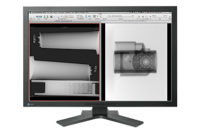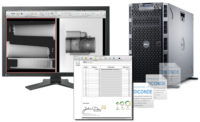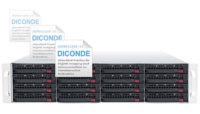Established in 1993, DICONDE (Digital Imaging and Communication for Non-Destructive Evaluation) is an imaging and archiving technology standard that defines all image attributes and elements in a universal format. DICONDE was based on DICOM (Digital Imaging and Communications in Medicine), a proven imaging and archiving standard in the medical industry. In 2004, the American Society for Testing and Materials (ASTM) E07.11 subcommittee made DICONDE the standard (E2339-11) for NDT (nondestructive testing) imaging.
With the transition to digital imaging in NDT underway, the industry and early adopters are looking at what other ways they can benefit from digital imaging once the basic archive is in place. Drawing from the medical imaging industry where digital imaging workflows are more mature, there are several applications that could be applied to digital NDT workflows that would greatly simplify the inspection and audit processes, eliminating potential rework, recalls, and associated costs. Key among them is records management.
Records management
In the medical industry, a networked software system called RIS (radiology information system) is used to manage the medical imaging process and associated data that is both digital and made digital. A RIS has several basic functions: patient tracking and scheduling, result reporting, image tracking, and billing. A RIS-like system could be used in an NDT digital workflow to improve management of several basic NDT functions: inspector certifications, quality assurance tracking, interpretation image measurements, report generation, and result sign-offs. To illustrate this concept and its benefits, we’ll look at a typical inspection and an audit in a rail car company.
Digital Archive
To start with, images of rail car components are all stored in a central digital archive; some were film that was scanned in, and some were taken digitally. The images are all stored with metadata (e.g., part, revision, inspector), which allows for quick image search and retrieval. As part of their new digital workflow, the rail car company also scans and digitally tracks all inspector certifications for compliance with requirements, such as bi-annual eye exams and level III written testing. Comparatively, many facilities are still keeping these records on paper. This can prove to be problematic, as we will discuss later.
Inspection
After viewing the images on the radiography workstation, the inspector for this rail car company needs to verify several thickness measurements of the assembly that must be documented in the quality control report. Because of their integrated system, the inspector uses a software tool to easily take the measurements on the parts. Then, with a simple click, the measurements are directly added to the digital report. In a more traditional facility, these measurements are hand written on QA forms. Handwriting styles and time pressure can often create a legibility issue, adding uncertainty and potentially invalidating the results.
Sign Off
With the findings indicated and measurements imported, the inspector is now ready to sign-off on the report, which he can simply do by entering his required authentication information and by clicking “approved.” Once he does so, the system will then work to verify the inspector’s credentials, ensure all certifications are current, and attach them to the final record. If a required certification can’t be verified, the system will alert the inspector of the issue. The report will remain in a draft state, and sign off will not be permitted until certification requirements are met or another inspector meeting the requirements verifies and signs-off.
Audit
With the report digitally stored with all associated and required imagery and data, which can be recalled by “inspector” or “date range,” an audit becomes very quick as manual steps are eliminated. For example, in a non-digital audit, searching for a file must be done manually through a traditional paper file system. Time must also be taken to obtain certifications, and manually verify report sign-off dates are within certification periods. Plus, there’s the risk of report legibility due to individual handwriting, and damaged paperwork (paperwork kept in binders often times makes the rounds of the shop floor, collecting coffee and oil stains along the way). With a digital workflow, any paper copies are known to be un-controlled copies. Another time factor in a non-digital audit is when supporting imagery is necessary. Looking for this often entails digging through boxes and barrels of film jackets. Plus, with safeguard controls built into the workflow, the risk of recalls and rework is greatly reduced or eliminated.
Making the digital transition
While the case for digital has been made in NDT and many other industries, understanding some common misconceptions can help you make a smooth transition.
• Disks are cheap and assumed safe. We heard this again at the last American Society for Nondestructive Testing conference in Las Vegas. The reality is, the larger your storage disk becomes, the more data that will inevitably be lost when that disk drive fails. Losing that data can mean losing a lawsuit if you can’t prove an inspection was completed. This is why a proper archiving solution is critical for any environment.
• Proprietary formats have the same search and organization functions as DICONDE. This is true; however, the data is locked into that vendor’s solution. With vendor neutral DICONDE, you are free to add scanners, inspection stations, and analysis software from other vendors to best meet your needs, and easily allow secure access.
• All files are created equal. Image data can be (sometimes unknowingly) stored in a format that is compressed “lossy,” where visual image data is discarded to decrease file size. This can lead to misinterpretation. DICONDE avoids this by natively storing in a lossless format, and clearly identifying when a lossy format was used.
• Images stored by file/folder name are safe. The file/folder name method for image identification is commonly used, but is a very error prone method of organizing image data. It provides no safeguards to accidental file moves, renames or deletes. And data recovery in the case of a file system crash is almost impossible. Image data may be recoverable, but file/folder names are lost, leaving you with a pile of images and no idea what they are or who they belong to. DICONDE solves this because of the integrated metadata.
• External hard drives stored in a file vault are safe. External hard drives on the market are designed for consumer use and have components that deteriorate on a shelf, similarly to tapes. These drives may fail to power up, and it’s only noticed when the data contained needs to be retrieved. DICONDE archives include options for special media designed for long shelf life with failure redundancy built-in.
• Digital is more expensive than a film workflow. While digital workflows have more of an upfront cost than film, the continued running costs are much less expensive. With the reduction, or elimination of film from the workflow, you gain all the productivity, security, and environmental benefits of digital while eliminating the expensive and ongoing cost of the film, and all its associated storage, handling, and shipping.
With the continued demand for more speed, security and cost reductions, we expect the trend towards digital in NDT to progress just as it did in the medical imaging industry. And, like the medical imaging industry, that digital evolution will include improvements in imaging techniques, tools for productivity improvements, and cost reduction with the use of solutions such as the digital records management as we outlined here for NDT inspections.
Reference Articles
Quality Magazine, April 2014. “Medical Imaging Technology for the Digital Transition of NDT”
Quality Magazine, February 2015. “Benefits of a digital workflow in NDT”



